We all face purchasing decisions, such as choosing a new car, many times in our lives. When it comes time to do it, our best intentions are to be rational in our choice, but we often end up letting our desires and intuitions take the lead ("look at the shiny red on that Mazda!") .
That's probably okay when it comes to cars (though your partner may disagree). But it's not okay for software that costs a lot and is relied on to help you care for patients or run your business.
For the best chance of a good outcome, method trumps feelings. You don't want to be drawn in by one or two advertised features only to find out that the rest of the software does not meet your needs. The whole is greater than the sum of the parts.
This guide leads you through a simple 3-step process, after which you'll have a score for two or more products. You might ignore the score when you make your decision. But that's fine. It's the process that counts. You will be much better informed and your subjectivity will be reduced.
Software doesn't come in shiny red, but software vendors know how to entice you in other ways, and you need to reduce that influence so you're in control.
1. Goals
It starts with goals. You need to know what they are. They're probably in your head already, in which case all you need to do now is to mentally run through them and check that they are clear and definite.
If you can't do that, then you should write down some ideas and ask others in the practice. This template will help you get going: Goals.
2. Gather requirements
What do you need to achieve your goals? Unless you're knowledgeable about IT, it can be hard to answer this question. A good way to start is to go to the websites of the products you know about and look at the features of each product. All vendors will describe their products by highlighting the features that they think are desirable to their customers.
For other ideas, your professional body may have recommendations, seek input from your colleagues, and also try our suggested requirements for different types of software.
Suggested requirements
- Clinical
- Supporting this list is a more detailed guide to clinical software requirements.
- Care planning
- The more detailed guide for clinical software could be used for care planning as well.
- Practice management
- Secure messaging
- Video consultations
3. Compare and assess products
Now you know what you need and why, you can assess the options. You probably have a product in mind. It's very important that you compare it with at least one other. Give your assessment the best chance of a close result by comparing the product with what you think is its strongest competitor.
Score each product in turn by testing them against your requirements list. To do this, you'll need to take them out for a test drive, in other words: get a demonstration of each product. If you were to compare and assess options for a car it might look something like this:

It may look scientific, but it's not (though it is methodical, and that's the point). You can't objectively prove that one product is better than another. A method like this keeps your goals in mind and reduces the chance of you being seduced by a feature that isn't really that important. You will be motivated to test that the feature really does what was advertised and does it as well as you think it should. Once again, it's the process that matters.
Going deeper (optional)
Readiness
How ready are you and your colleagues to implement and use a new system? You might think you're ready as you can be, or you might have no choice, you just have to do it anyway. But it will probably still help if you take 5 minutes to score yourself using this readiness assessment: Readiness assessment template.
Benefits
With your goals set, you can use them to get identify the benefits you'll get from achieving your goals. You should document them, but in reality, you probably don't have the time. As with the goals, mentally run through them, and make sure that you will always be able to readily nominate two or three very significant benefits you'll get from buying new software.
If you do have some time, or need a framework to think about benefits, use this template: Benefits template.
Plan
Everything you do should be planned. And plans should be documented. Once again, you are in general practice and it's highly likely you don't have the time to write a plan. That's okay, but in this we insist that you at least document a timeline. In this pre-filled project plan template there is a timeline that you can copy and paste. While you're there, we hope you're tempted to use the whole plan.
